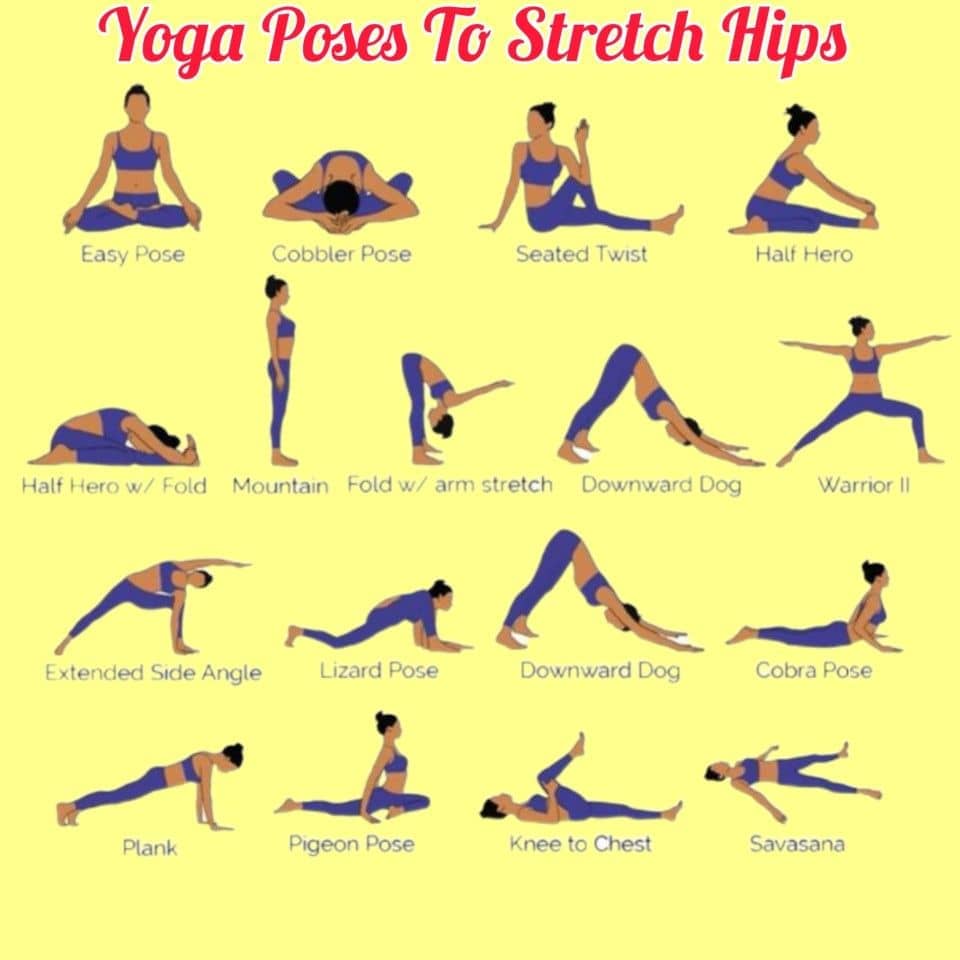Yoga Poses to Stretch and Open Your Hips: A Comprehensive Guide
Are you looking to relieve tension in your hips, increase flexibility, and enhance your overall sense of well-being? The hips are one of the largest and most complex joints in the body, supporting us through daily activities such as walking, running, standing, and even sitting. Unfortunately, modern sedentary lifestyles and prolonged hours sitting at desks can lead to tight hips, discomfort, and even lower back pain. In this article, we will explore a series of yoga poses specifically designed to stretch and open your hips. By integrating these poses into your routine, you can potentially improve your range of motion, ease muscle tension, and maintain better posture.
Below, we will cover each pose in detail, discussing proper alignment, modifications for beginners, as well as tips for deriving the most benefit from each posture. Remember to consult your healthcare professional before starting any new exercise program—especially if you have a history of injuries or pre-existing medical conditions. Let’s get started on your journey to healthier, more flexible hips!
Table of Contents
- Why Hip-Opening Yoga Poses Matter
- Yoga Practice Essentials
- Easy Pose (Sukhasana)
- Cobbler Pose (Baddha Konasana)
- Seated Twist (Ardha Matsyendrasana Variation)
- Half Hero Pose (Ardha Virasana)
- Half Hero With Fold
- Mountain Pose (Tadasana)
- Forward Fold With Arm Stretch (Uttanasana Variation)
- Downward-Facing Dog (Adho Mukha Svanasana)
- Warrior II (Virabhadrasana II)
- Extended Side Angle (Utthita Parsvakonasana)
- Lizard Pose (Utthan Pristhasana)
- Downward-Facing Dog (Repeat)
- Cobra Pose (Bhujangasana)
- Plank Pose (Phalakasana)
- Pigeon Pose (Eka Pada Rajakapotasana)
- Knee-to-Chest Pose (Apanasana)
- Savasana (Corpse Pose)
- Tips for a Safe Hip-Opening Practice
- Conclusion
1. Why Hip-Opening Yoga Poses Matter
The hip joint, a ball-and-socket structure, allows for a wide range of motion in the legs and pelvis. Over time, factors such as extended sitting, repetitive sports motions, or carrying heavy loads can create tightness or misalignment in the hips. Hip-openers can help:
- Relieve Tension: Stretching and relaxing the major muscles around the hip (like the glutes, hip flexors, and quadriceps) can prevent or reduce discomfort.
- Improve Posture: When your hips are more mobile, your spine can align more effectively, reducing lower back strain.
- Enhance Athletic Performance: A flexible hip region can lead to better stability, mobility, and overall performance in running, hiking, and other sports.
- Support Emotional Release: In many yoga traditions, the hips are believed to store stress or emotional tension. Hip-opening poses may help release stored emotions and promote a sense of well-being.
2. Yoga Practice Essentials
Before beginning, make sure you have:
- A Comfortable Yoga Mat: Provide cushioning and avoid slipping by using a good-quality mat.
- Proper Attire: Wear clothes that allow free movement without restricting your range of motion.
- Water and a Towel: Staying hydrated and keeping sweat in check can make the experience more pleasant.
- Optional Props: Yoga blocks, straps, or bolsters can help you modify poses to meet your current flexibility level.
Safety Disclaimer
Listen to your body. Do not push yourself to the point of pain. If any pose causes discomfort, carefully back out of the posture and consider alternative modifications. Always consult with a healthcare provider for personalized guidance if you are dealing with injuries or chronic conditions.
3. Easy Pose (Sukhasana)
Overview: Often used for meditation and breathing exercises, Easy Pose helps gently stretch your hips and lower back, setting a calm and focused tone.
How to Do It:
- Sit on the floor with legs crossed comfortably.
- Lengthen your spine, lifting from the crown of your head.
- Rest your hands on your knees, palms facing down or up.
- Close your eyes and take slow, deep breaths.
Tips:
- Use a folded blanket or cushion under your sit bones if you feel any pain or discomfort in your hips.
- Maintain a tall spine and avoid slouching.
4. Cobbler Pose (Baddha Konasana)
Overview: Also known as Bound Angle Pose, Cobbler Pose is a classic hip-opener that stretches the groin and inner thighs.
How to Do It:
- Begin seated with legs extended.
- Bend your knees, bringing the soles of your feet together.
- Allow your knees to fall outward gently.
- Wrap your hands around your feet or ankles, drawing them closer to the groin.
- Keep your spine upright, chest lifted.
Tips:
- You can place cushions or yoga blocks under the knees if this posture strains your hips.
- Focus on a smooth, steady breath to help muscles relax.
5. Seated Twist (Ardha Matsyendrasana Variation)
Overview: Twisting poses not only help open the hips indirectly but also improve spinal mobility. This seated variation focuses on targeting the outer hip and glute area.
How to Do It:
- Sit on the floor with legs extended.
- Bend one knee, place the foot outside the opposite thigh.
- Wrap your opposite arm around the bent knee, twisting from the waist.
- Lengthen your spine on every inhale, and deepen the twist on the exhale.
Tips:
- Keep both sit bones anchored on the floor as much as possible.
- If twisting deeply strains your back, use your free hand on the ground behind you for support.
6. Half Hero Pose (Ardha Virasana)
Overview: This pose targets the quadriceps and hip flexors, key contributors to hip tightness. Approach it gently if you have knee issues.
How to Do It:
- Kneel on the floor.
- Extend one leg forward while keeping the other knee bent, foot behind your buttocks.
- Place your hands on your hips or on the floor for balance.
- Keep the torso upright, gently stretching the front of your thigh.
Tips:
- To protect your knee, place a cushion under the bent knee or use extra padding under the shin.
- Engage your core to maintain balance and support the lower back.
7. Half Hero With Fold
Overview: A deeper variation of Half Hero Pose, this adds a forward fold for an intensified hip and thigh stretch.
How to Do It:
- From Half Hero Pose, carefully fold forward from the hips.
- Rest your forearms or hands on the ground if possible.
- Keep the extended leg straight, pointing toes upward.
- Breathe slowly, feeling the stretch along the bent leg’s quadriceps and hip flexors.
Tips:
- Avoid straining; if you feel knee pressure, come back to the standard Half Hero Pose.
- Engage your abdominal muscles to support the forward fold.
8. Mountain Pose (Tadasana)
Overview: Mountain Pose may seem simple, but it sets the foundation for proper alignment throughout your yoga practice. A properly aligned Mountain Pose can help you identify any imbalances in your hips.
How to Do It:
- Stand tall with feet hip-distance apart.
- Ground evenly through your feet, distributing weight equally.
- Roll your shoulders back, keeping them relaxed.
- Engage your core and lengthen your spine.
Tips:
- Imagine a straight line running from the crown of your head through your heels.
- Maintain a slight bend in the knees to avoid locking them.
9. Forward Fold With Arm Stretch (Uttanasana Variation)
Overview: A forward fold naturally stretches the hamstrings and lower back, which can relieve tension around the hips. Adding an arm stretch further engages the shoulders and upper back.
How to Do It:
- From Mountain Pose, inhale and lengthen your spine.
- Exhale, hinge at the hips, folding forward.
- Interlace your fingers behind your back and let your arms stretch up and away from your lower back.
- Keep a micro-bend in your knees if your hamstrings are tight.
Tips:
- If reaching your arms overhead is too intense, keep your hands on your hips or use a strap.
- Relax your neck and allow your head to hang heavy.
10. Downward-Facing Dog (Adho Mukha Svanasana)
Overview: One of the most recognized yoga poses, Downward Dog stretches the entire posterior chain (calves, hamstrings, and lower back) while also opening the hips and strengthening your arms and shoulders.
How to Do It:
- Begin on all fours, with wrists under shoulders and knees under hips.
- Curl your toes under, pressing your hips toward the sky.
- Straighten your legs as much as comfortable; keep a slight bend in the knees if needed.
- Spread your fingers and press firmly into the mat.
Tips:
- Lengthen the spine by pushing the ground away with your hands.
- If your lower back feels rounded, bend your knees more and focus on keeping your spine long.
11. Warrior II (Virabhadrasana II)
Overview: Warrior II strengthens the legs, opens the hips, and builds stamina. It also boosts balance and mental focus.
How to Do It:
- Stand with feet wide apart.
- Turn one foot out 90 degrees, aligning the heel with the arch of the back foot.
- Bend your front knee over the ankle, creating a right angle.
- Extend your arms parallel to the floor, gazing over your front hand.
Tips:
- Keep your shoulders relaxed and your torso straight.
- Engage your core to protect your lower back.
- Press through both feet to feel grounded and stable.
12. Extended Side Angle (Utthita Parsvakonasana)
Overview: This posture provides a deep stretch in the hips and waist. It also strengthens the legs and improves balance.
How to Do It:
- From Warrior II, lean forward over the bent knee.
- Place your front hand on a block or on the ground near your foot.
- Extend your top arm overhead, creating a long line from your back foot to your fingertips.
- Keep the chest open and hips low.
Tips:
13. Lizard Pose (Utthan Pristhasana)
Overview: Lizard Pose deeply targets the hip flexors and groin, making it ideal for releasing tight hips. Approach it with caution, as it can be intense.
How to Do It:
- Begin in a low lunge, placing the front foot slightly to the outer edge of the mat.
- Place both hands inside the front foot, palms or forearms on the ground.
- Keep your back leg engaged, pressing through the heel.
- Allow the hips to sink without collapsing your lower back.
Tips:
- If forearms on the floor is too deep, stay on your palms or use blocks.
- Keep your front knee in line with your toes to protect the joint.
14. Downward-Facing Dog (Repeat)
Overview: Revisiting Downward-Facing Dog can act as a reset between intense hip-openers, providing a moment to lengthen the spine and release tension from the entire body.
Key Focus:
- Keep your spine long.
- Press your chest gently toward your thighs.
15. Cobra Pose (Bhujangasana)
Overview: While Cobra Pose primarily focuses on backbend and spine extension, it also opens up the front of the hips by engaging the lower body.
How to Do It:
- Lie on your belly, legs extended, tops of feet on the floor.
- Place your palms beside your ribs.
- Inhale, lift your chest while keeping hips and legs grounded.
- Draw your shoulders back, opening the front of your body.
Tips:
- Engage your core and buttocks to protect your lower back.
- Keep your elbows close to your body.
16. Plank Pose (Phalakasana)
Overview: Although Plank Pose may not seem like a direct hip opener, it engages the hip flexors and core, creating stability that can support other hip-opening poses.
How to Do It:
- From Cobra, press up onto your hands and toes.
- Align shoulders over wrists, maintaining a straight line from head to heels.
- Engage your abdominal muscles and avoid sagging your hips.
- Keep your gaze slightly forward.
Tips:
- If you feel strain in your lower back, drop to your knees for a modified Plank.
- Keep your neck long by tucking your chin slightly.
17. Pigeon Pose (Eka Pada Rajakapotasana)
Overview: This is one of the most popular yoga poses for targeting deep hip and glute tension. Pigeon Pose stretches the piriformis and gluteal muscles, which can alleviate lower back and sciatic discomfort for some practitioners.
How to Do It:
- From Downward-Facing Dog, bring one knee forward behind the corresponding wrist.
- Extend your other leg straight behind you, hips square to the front.
- Lower your chest over your bent leg, using forearms or a prop for support.
- Keep your hips level and breathe steadily into the stretch.
Tips:
- If your hips are too tight, place a folded blanket or a block under the bent hip.
- Focus on keeping your spine long, and do not force your torso to the floor.
18. Knee-to-Chest Pose (Apanasana)
Overview: Knee-to-Chest is a gentle pose that can help release tension in the lower back and hips, perfect as a cooldown or finishing posture.
How to Do It:
- Lie on your back.
- Draw one or both knees toward your chest.
- Wrap your arms around your shins.
- Keep your lower back on the ground and breathe deeply.
Tips:
- Rock side to side to massage your spine.
- If drawing both knees in feels too intense, do one knee at a time.
19. Savasana (Corpse Pose)
Overview: The ultimate relaxation pose, Savasana allows your body to integrate the benefits of your practice. Though not a “hip opener,” it’s crucial for letting tension dissolve.
How to Do It:
- Lie flat on your back, legs extended, arms at your sides.
- Close your eyes and allow your feet to fall open naturally.
- Soften your jaw, facial muscles, and shoulders.
- Stay here for 5–10 minutes, focusing on slow, steady breathing.
Tips:
- Use a blanket for warmth or a bolster under your knees to relieve lower back pressure.
- Mentally scan your body, releasing any residual tension.
20. Tips for a Safe Hip-Opening Practice
- Warm Up Properly: Incorporate gentle movements such as Cat-Cow stretches or a brief walk to prepare your body.
- Use Props: Blocks, straps, and bolsters can help you ease into deeper stretches gradually.
- Breathe Mindfully: Slow, intentional breathing helps your muscles relax and lengthens your exhalation, which can deepen your stretch.
- Avoid Pain: Some discomfort or sensation is natural, but sharp or shooting pain is a sign to back off.
- Stay Consistent: Regular practice yields better results than occasional sessions. Even 10–15 minutes a day can lead to noticeable improvements.
- Cool Down: End with relaxing poses such as Happy Baby or a gentle reclined twist before transitioning to Savasana.
- Listen to Your Body: Every body is different. Respect your limits and modify poses as needed.
21. Conclusion
Tight hips can affect everything from your posture to your daily comfort. By incorporating these hip-opening yoga poses—such as Easy Pose, Cobbler Pose, Lizard Pose, Pigeon Pose, and more—you can gradually improve mobility, reduce discomfort, and enhance your overall sense of well-being. Remember to practice mindfully, using props when necessary, and always listen to your body’s signals. Over time, a consistent yoga routine can lead to healthier hips, a stronger core, and a more balanced body and mind.
By sharing these poses and tips, we hope to guide you on a journey towards greater hip flexibility and body awareness. Whether you’re new to yoga or looking to deepen your practice, these hip-opening stretches can be an essential component of your wellness routine. As with any exercise, consult a healthcare professional if you have any concerns, and never push yourself to the point of pain.
Give these poses a try, and feel free to share your experience or questions in the comments below. Here’s to a healthy, happy, and flexible set of hips!










